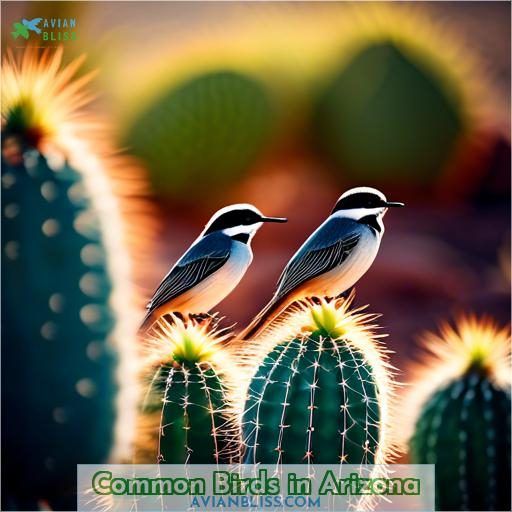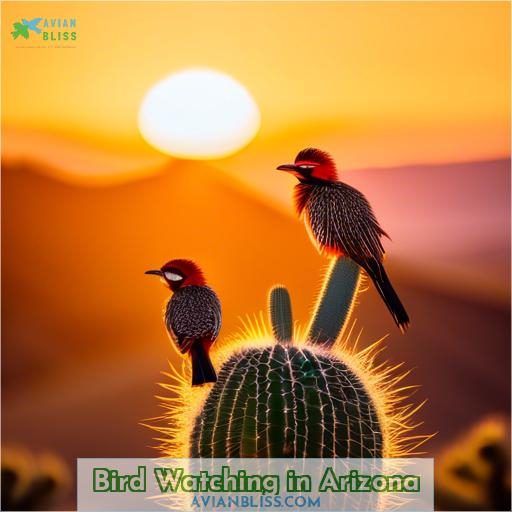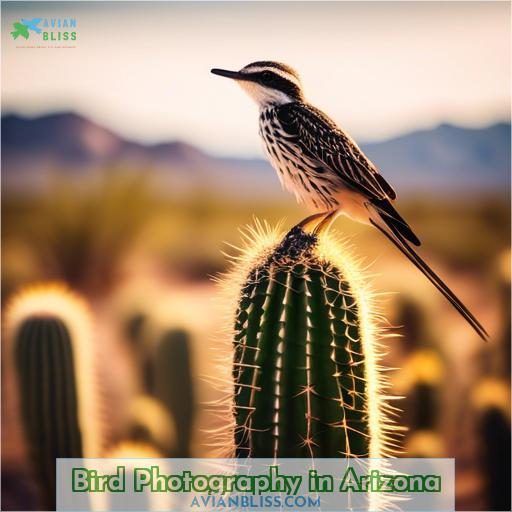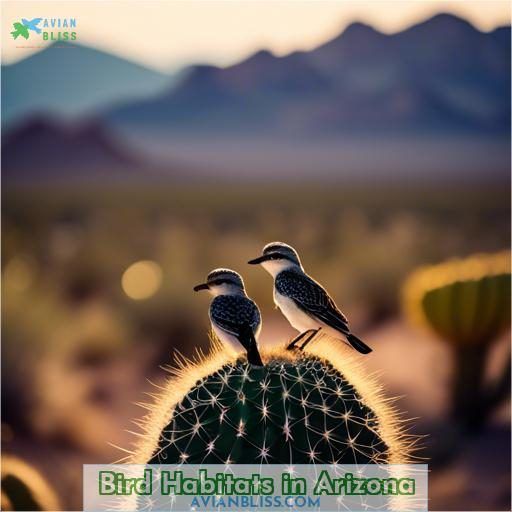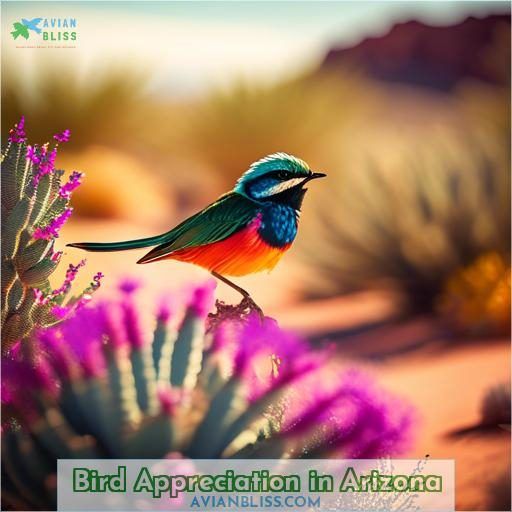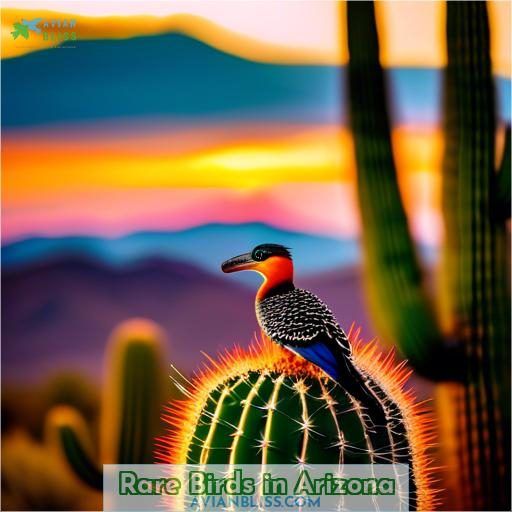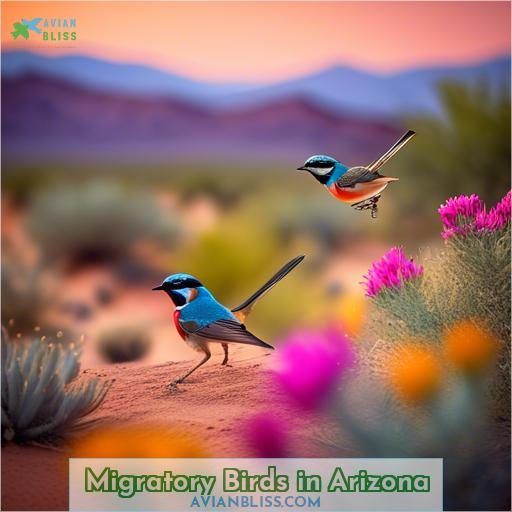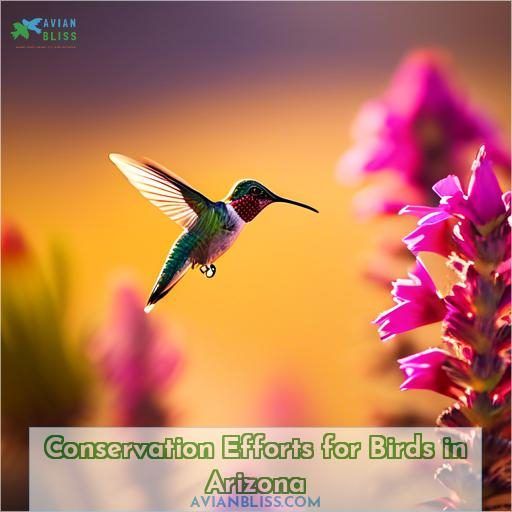This site is supported by our readers. We may earn a commission, at no cost to you, if you purchase through links.
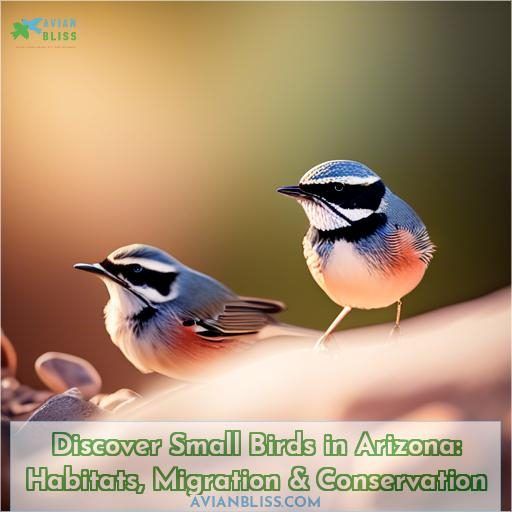
Arizona is home to a diverse array of small birds, including the Calliope Hummingbird, which is the state’s smallest bird at 3.25 inches. Hummingbirds are known for their territorial behavior and unique hovering feeding style.
Sparrows, another common small bird in Arizona, consume seeds and insects in open habitats. Birdwatching in Arizona is a popular activity, with state parks offering privileged vantage points to observe various bird species. Binoculars, field guides, and bird identification apps are essential tools for birdwatching.
Small birds in Arizona inhabit various habitats, from desert landscapes to mountainous regions. Observing these birds provides insight into conservation efforts and fosters a connection with nature.
Table Of Contents
Key Takeaways
- Arizona is home to a diverse array of small birds, including the Calliope Hummingbird, which is the state’s smallest bird at 3.25 inches.
- Conservation efforts for small birds in Arizona are a collaborative endeavor involving various organizations, landowners, and the public.
- Birdwatching is a popular recreational activity in Arizona, with numerous state parks providing opportunities to observe a variety of avian species.
- Small birds in Arizona inhabit various habitats, from desert landscapes to mountainous regions, and their observation provides insight into conservation efforts and fosters a connection with nature.
Small Birds in Arizona
Explore the Captivating Realm of Small Birds in Arizona
Arizona is a birdwatcher’s sanctuary, boasting a diverse array of avian species inhabiting various ecological niches across the state. Small birds are particularly intriguing, as they often exhibit unique traits and preferences that make them a delight to observe. In this section, we’ll embark on a journey into the realm of small birds in Arizona, examining their distribution, behaviors, habitats, and conservation endeavors.
Small Bird Dimensions and Distribution
Small birds in Arizona span a range of sizes, from the diminutive hummingbirds to sparrows, with a variety of species thriving throughout the state. Some of the most prevalent small birds include the Calliope Hummingbird, the state’s smallest bird at 3.25 inches in length, and the Abert’s Towhee, a native desert bird commonly found in arid yards. Other small birds, such as the Anna’s Hummingbird and the Verdin, are frequently encountered in urban environments and riparian habitats.
Small Bird Behaviors and Habitat Preferences
Small birds in Arizona exhibit a wide range of behaviors and preferences, dictated by their habitat and dietary needs. For instance, hummingbirds are renowned for their territorial behavior and their ability to hover mid-air while feeding on nectar. In contrast, sparrows are terrestrial birds that favor open habitats and often consume seeds and insects.
Small Bird Conservation in Arizona
Conservation efforts for small birds in Arizona form an integral part of the Arizona Bird Conservation Initiative (ABCI), a collaborative partnership involving government agencies, conservation organizations, academic institutions, private businesses, and citizens dedicated to protecting, monitoring, and enhancing bird populations and their habitats. The ABCI coordinates the Arizona Coordinated Bird Monitoring Program (AZCBM), which supports projects aimed at determining species status, distribution, and long-term population trends for breeding and wintering birds in Arizona.
Complementing these efforts, the Important Bird Areas (IBA) program, coordinated by Audubon Southwest, engages citizens in bird conservation by fostering their appreciation for and understanding of natural heritage. The program strives to cultivate empathy and encourage actions that recognize the impact on the environment and promote its preservation.
Bird Watching and Identification
Birdwatching is a popular recreational activity in Arizona, with numerous state parks providing opportunities to observe a variety of avian species. For instance, Dead Horse Ranch State Park in northern Arizona serves as a nesting ground for black hawks, waterfowl, bald eagles, and blue herons. In southern Arizona, Kartchner Caverns State Park is renowned for its sparrows, hummingbirds, doves, roadrunners, owls, and other bird species.
Identifying birds can be a challenge, but utilizing photographs, consulting bird profiles, comparing head shape, beak size, and tail length, and seeking guidance from experienced birders can all aid in the identification process.
Common Birds in Arizona
Exploring the diverse bird population of Arizona is a treat for any bird enthusiast. From the American goldfinch and black-capped chickadee to the house wren and downy woodpecker, Arizona is home to a wide range of bird species. Seasonal sightings vary, with winter visitors like the lesser goldfinch adding to the richness of the avian scene.
Feeding stations are popular spots for bird photography, capturing the vibrant colors and unique features of these birds. Keep an eye out for winter visitors like the American goldfinch and black-capped chickadee, as well as year-round residents like the house wren and downy woodpecker. Don’t forget to visit the feeding stations for a chance to photograph these beautiful birds in their natural habitat.
Bird Watching in Arizona
After exploring the common birds of Arizona, let’s embark on a journey of bird watching in this vibrant state. Equipped with binoculars and a field guide, you’re ready to unravel the mysteries of bird behavior and migration.
- State parks offer a privileged vantage point to witness this spectacle, particularly in riparian zones and the renowned red rock country.
- Observing bird varieties in their natural habitat provides valuable insight into their conservation.
- Witnessing bird migration serves as a testament to nature’s unwavering rhythm, a liberating experience that fosters a connection with the untamed wilderness.
Bird Identification in Arizona
Bird identification in Arizona is a fascinating and rewarding hobby for both beginners and experienced birdwatchers. With over 563 bird species native to the state, there’s no shortage of feathered friends to discover. To help you identify the birds you encounter, here are some tips and a table to guide you:
- Use photos for identification: Take pictures of the birds you see and compare them to photos in field guides or online resources.
- Scan through bird profiles: Look for matches in terms of head shape, beak size, tail length, and overall size and color.
- Consider bird size and wing color: Larger birds with darker wings, like the American Crow or the Common Raven, can be easier to identify.
- Seek help from experienced birders: Join local birding groups or clubs to learn from others with more experience.
- Use a bird identification app: There are several apps available that can help you identify birds based on their characteristics.
To make your bird identification journey even more enjoyable, consider creating a bird identification table like the one below:
| Bird Species | Description |
|---|---|
| Gila Woodpecker | Large, black-and-white woodpecker with a distinctive red crest |
| House Finch | Small, brown and gray bird with a bold pattern on its head |
| Anna’s Hummingbird | Small, colorful hummingbird with a distinctive forked tail |
| Cactus Wren | Small, brown bird with a distinctive white eyebrow |
| Cooper’s Hawk | Medium-sized, brown-and-white raptor with a distinctive white eyebrow |
Bird Photography in Arizona
After attaining proficiency in bird identification, you’re prepared to embark on bird photography in Arizona. Arming yourself with the appropriate bird photography equipment is essential; consider it your guide to capturing these aerial marvels. Bear in mind, patience is your steadfast companion, and adhering to ethical bird photography practices guarantees you honor their natural environments.
Whether it’s the migratory season or a protected area, your lens can convey compelling narratives. Thus, gather your bird photography gear, and let’s transform each photograph into a tribute to the splendor and tenacity of Arizona’s birds.
Bird Habitats in Arizona
Explore the diverse bird habitats in Arizona, where small birds thrive. During migration, these habitats provide essential rest stops for weary travelers. Conservation efforts protect these habitats, ensuring small birds can continue to flourish.
Set up bird feeders, birdhouses, nesting boxes, and bird baths to attract a variety of species. Enjoy the freedom of observing these creatures in their natural environments.
Bird Appreciation in Arizona
In Arizona, your backyard can transform into a vibrant stage for small birds, where bird feeders and houses play the lead roles. Imagine sipping your morning coffee to the symphony of bird songs and calls, a daily dose of desert serenity.
Backyard birding isn’t just a hobby; it’s a gateway to appreciating the feathered wonders traversing Arizona’s diverse habitats. Chuckle as you outwit squirrels from bird feeders, and let the joy of bird appreciation take flight in your heart.
Rare Birds in Arizona
Arizona is home to a diverse array of bird species, with over 551 bird species and subspecies found in the state. However, many of these species face threats due to habitat destruction, invasive species, and other human activities. In this article, we’ll discuss the rare birds in Arizona, the conservation efforts to protect them, and the endangered species in the state.
Arizona has a variety of rare birds, some of which are on the brink of extinction. These include the Western Yellow-billed Cuckoo, Mexican Spotted Owl, and the California Condor, which are endangered under the U.S. Endangered Species Act (ESA). Other rare birds in Arizona include the Abert’s Towhee, Arizona Woodpecker, and the Black Rail, which are listed as Threatened or Endangered under the ESA. Additionally, the Bendire’s Thrasher, Blue-throated Mountain-gem, Botteri’s Sparrow, and Willow Flycatcher are on the Arizona Watch List, which includes species that are vulnerable or of concern.
Conservation Efforts:
To protect these rare birds, various conservation efforts are underway. The Arizona Bird Conservation Initiative (ABCI) is a voluntary partnership of government agencies, conservation groups, academic institutions, private businesses, and citizens working to conserve, monitor, and enhance bird populations and their habitats. The Arizona Coordinated Bird Monitoring Program (AZCBM) coordinates existing projects, supports projects implemented by partners, and collaborates on the design and implementation of new projects to determine species status, distribution, and long-term population trends for breeding and wintering birds in Arizona.
Endangered Species:
The Western Yellow-billed Cuckoo, Mexican Spotted Owl, and California Condor are endangered species in Arizona. The Western Yellow-billed Cuckoo is threatened by habitat loss and fragmentation, while the Mexican Spotted Owl faces threats from habitat destruction and fragmentation, as well as competition with the invasive Eurasian Collared-Dove. The California Condor is threatened by habitat loss, lead poisoning, and collisions with power lines.
Migratory Birds in Arizona
Migratory birds play a significant role in Arizona’s diverse avian population. During their journeys, they rely on stopover sites for rest and refueling. These stopover sites are essential for their survival, especially during long-distance migrations. In Arizona, hummingbirds are among the most migratory species, with the Rufous Hummingbird holding the record for the longest migration of any hummingbird.
Long-term studies conducted by the Southeastern Arizona Bird Observatory involve capturing, banding, weighing, and measuring migratory birds to understand their life cycles, migration routes, and the importance of specific nesting, wintering, and migration stopover sites. This information is indispensable for conservation efforts, as it helps us understand the health of bird populations and the impact of climate change on their migratory patterns.
Conservation initiatives are fundamental to protect and preserve these vital stopover sites. The Migratory Bird Treaty Act protects native birds, and federal permits are required for activities such as banding that involve the capture and handling of wild birds. By understanding and monitoring migratory bird behavior, we can develop strategies to lessen the effects of climate change and other threats on their populations.
Migratory birds in Arizona include species such as the Western Yellow-billed Cuckoo, Mexican Spotted Owl, and the Rufous Hummingbird, which are listed as threatened or endangered under the U.S. Endangered Species Act (ESA). It’s critical to work towards their recovery while also keeping an eye on common birds that may face similar threats in the future.
Conservation Efforts for Birds in Arizona
Conservation efforts for birds in Arizona are a collaborative endeavor involving various organizations, landowners, and the public. Here are four key aspects of these efforts:
- Bird population monitoring: Organizations like Tucson Audubon and the Arizona Wildlife Federation conduct research and monitoring programs to determine species status, distribution, and long-term population trends for breeding and wintering birds in Arizona.
- Habitat restoration: Tucson Audubon works to restore and protect the ecosystem, focusing on riparian areas and using standard habitat restoration techniques as well as innovative methods from permaculture. The Central Arizona Land Trust (CALT) also collaborates with landowners to create conservation easements, preserving critical riparian habitats for endangered bird species like the southwestern willow flycatcher and yellow-billed cuckoo.
- Education and outreach: The Arizona Wildlife Federation offers year-round education programs across Arizona, engaging the public in protecting wildlife, connecting with legislators, and participating in conservation projects. Tucson Audubon also actively works with researchers on critical species conservation issues.
- Citizen science and collaboration with landowners: Projects like Project FeederWatch, coordinated by the Cornell Lab of Ornithology, involve the public in collecting data on bird populations, which can inform conservation efforts. CALT works with private landowners to develop conservation easements, ensuring the long-term protection of critical habitats.
These conservation efforts aim to keep common bird species common and highlight declining species in need of research and conservation efforts. Collaboration with landowners and citizen science projects are indispensable components of these efforts, providing valuable data and engaging the public in conservation efforts.
Conclusion
Arizona is a birdwatcher’s haven, teeming with a diverse array of small birds that inhabit various habitats, from desert landscapes to mountainous regions. From the tiny Calliope Hummingbird to the common Sparrow, observing these birds provides a unique connection with nature and fosters appreciation for conservation efforts.
Whether you’re a seasoned birdwatcher or a nature enthusiast, Arizona’s bird population serves as a demonstration of the beauty and diversity of our planet’s wildlife.

